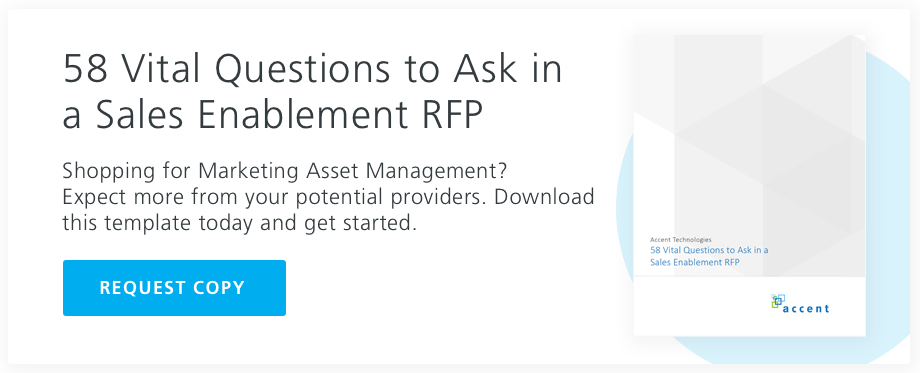uncategorised
Marketing Asset Management
Is your business creating huge amounts of marketing materials? As businesses grow and expand into different markets, new customers need new content.
If this is you, it’s time we talked about Marketing Asset Management. Managing your marketing assets isn’t very glamorous, but it’s critical to get a positive ROI out of your collateral.
What is Marketing Asset Management?
Marketing asset management is a subsection of a digital asset management program. The goal here is to niche down your focus from managing all the company’s assets. Company-wide assets go far beyond the scope of marketing asset management. We want to first focus on managing our marketing materials, as these are often the most used with customers.
Why would you want to do this? Let’s dive in.
Marketing assets — whether digital, physical, or a combination of both – take time and money to create. And yet according to this report, roughly 70 percent of created assets are never used. That’s untold hours and dollars tossed into the void. Even worse, of the 30 percent or so that do get used, many are used once and then lost.
Sales reps neglect to use these materials for the following reasons:
- They’re stored somewhere cumbersome or inaccessible to employees. This may be a convoluted Google Drive folder hierarchy or an antiquated intranet system.
- They’re outdated and don’t reflect the current reality of your product or service. Reps can’t risk making a poor impression on their prospects with obsolete information.
- They’re not labeled with a consistent naming convention. “SMP_2021_FINAL_V2.PDF” is not a helpful designation if nobody knows these abbreviations.
A marketing asset management program can pay for itself by eliminating these issues. Marketing asset management software centralizes assets and ensures they’re accessible to all stakeholders.
It labels everything with a uniform taxonomy using metadata, so everyone knows:
- Exactly what the file is
- Its creation date
- Its proper use case
And they know this without having to do a deep research dive. Additionally, the assets are updatable, so there’s no excuse for using outdated materials. Paying for assets that are never used or rebuying assets you already own is a huge waste. Marketing asset management provides a simple solution to these problems. (Want to learn more about digital asset management? We’ve got you covered. See link below.)
SEE ALSO: Understanding Digital Asset Management

Why is Marketing Asset Management Software Important?
Not having a marketing asset management system complicates what should be simple.
As an example, say you’ve published an eBook on a topic related to your industry. As time passes, that asset becomes outdated and is ready for an updated version. What happens when no one can find the original file?
This isn’t an issue when a marketing asset management system is in place.
In the original example, someone must recreate that original document from scratch. This takes them away from focusing on their more pressing day-to-day duties. Taking it a step further, how do you know who was using the original version of this e-book? If you don’t know, how can you be sure they get the updated version and have access to the newest information?
This sort of disorganization not only influences revenue and expenses but can also hurt your branding. No one wants to be known for pushing outdated information. Now, imagine this same sort of scenario with all your various marketing assets. Seem like a nightmare? Unfortunately, it is for many companies. Far too often, marketing teams wait until things are completely out of control before turning to asset management. Don’t let that be you.
The ROI of Marketing Asset Management Software
The one overarching goal of a marketing asset management program is making things simpler. And more streamlined when it comes to wrangling your marketing materials. With that said, there are several different ways marketing asset management can help you achieve this goal.
By making it faster and easier to find assets you can gain these benefits:
- Reduce time wasted searching for assets you’ve already created
- Drop the need to “reinvent the wheel” with each new asset
- Increase productivity and financial growth
- End the need to help others find missing assets
- Share marketing assets with team members around the globe
- Stop re-purchasing assets because you can’t locate them.
- Share your marketing assets across a wide range of platforms and devices
- Analyze stats to see what marketing assets are being used most often
- Easily find assets to repurpose or update
- Guarantee all marketing assets are in line with current branding goals
There are even more benefits to a good marketing management system, some of which will be exclusive to your company. But the big takeaway here is that investing in asset management can:
- Save money
- Streamline operations
- And guarantee all your marketing materials are up-to-date and accessible to everyone who needs them.
How Does Marketing Asset Management Work?
There are distinct differences between digital asset management and marketing asset management. Yet both work in similar ways as far as setup and systems go. Both digital asset management and marketing asset management rely heavily on software. This software is either cloud-based or local to your premise.
Both ensure that assets are easily accessible and searchable by creating a naming convention or taxonomy. This system is similar to the Dewey Decimal System found in almost all libraries.
This keeps mission-critical assets organized, accessible, and crystal clear. Users can see all the relevant metadata and details about an asset without having to guess what it might be.
All marketing stakeholders will have access to this centralized storage hub. This means they can both store and download the assets they need from anywhere in the world.
If you’re ambitious, you might have a marketing asset manager who oversees all this. Their job is to guarantee everyone is trained on the proper taxonomy and metadata practices.
That said, a strong marketing asset management software mitigates the need for constant training. Once the systems are in place, the system pretty much runs itself. Because of this, a dedicated manager is a luxury, not a necessity. Unless, of course, you have a giant company with a huge marketing department. Mid to large companies like these may need an employee dedicated to running the system.
Most startup or growth-sized companies aren’t working with hundreds and hundreds of assets. This means you may need a few hours per month of maintenance and data cleanup, but not much more than that. As far as setting up this sort of system goes, it’s almost identical to setting up digital asset management. Here are some steps to get you started.
1. Make a Plan:
It’s tempting to jump in and impulse-buy software, but it’s good to start with a plan.
Define your marketing asset management goals:
- Who will be in charge of this project?
- What will your taxonomy look like?
- Who will have access to these materials?
- What materials need storing?
Planning now can prevent future headaches. Take the time and define your objectives before diving in headfirst.
2. Audit your Assets:
It’s critical to have a full accounting of all your marketing assets before purchasing software. This helps you visualize how much collateral you have and often reveals blind spots in your content strategy.
You won’t get the most out of your system if you’ve got assets that languishing in limbo.
3. Set Your Objectives:
With the plan and audit in place, it’s time to start defining objectives:
- What are your biggest challenges in regards to marketing asset management?
- What does a good ROI look like for your team?
- What’s the best-case scenario for how software can help you reach those goals?
If you’re not aiming at a target, you can’t expect to hit the bullseye. Take some time to internalize what you hope to gain through asset management software.
4. Test, Troubleshoot, and Adjust:
Once your marketing asset management system rollout happens, it’s time to start evaluating how things are working. Test the system with rigor. Is it delivering the results you want? If not, dig deep into your reports and figure out where the bottlenecks are.
If you’re using a SaaS solution, call up their support or customer success line. These experts exist to make sure you achieve your goals with their solution. Don’t hesitate to leverage their knowledge.
Once you’ve diagnosed the issues, adjust your approach. It’s not about perfection, but small, incremental improvements.
Can I use my Digital Asset Management System for Marketing?
If you already have a digital asset management system in place, you may be wondering if you can use that for your marketing asset management needs. And the short answer is yes.
That said, not every company needs a full-on digital asset management program. Others may want to find a solution built for their marketing department. Otherwise, you risk “feature bloat.” This refers to programs with features, bells, and whistles that you simply don’t need. The result is a convoluted user experience (and a more expensive price tag).
If you find yourself in either of those situations, a dedicated marketing asset management program might be the better path.
The good news is, regardless of what path you take, there are plenty of great options available. Any good asset management software company will create a solution that caters to your specific needs.
If they don’t, there are plenty of other companies that will. Do your homework, shop around and talk to different solution providers before deciding.
Top Marketing Asset Management Solutions
Here are some of the top marketing asset management solutions available today.
Accent Technologies
Accent combines world-class content management with AI-driven guided selling to deliver the world’s most powerful sales enablement platform. It empowers reps with the resources and collateral they need to sell with confidence.
Accent’s marketing asset management system stores, categorizes, and recommends marketing assets based on contextual signals. It also analyzes historical prospect data and recommends content based on relevant factors. This eliminates the need for reps to hunt through email threads or vague intranet folders to find the right asset.
Our content delivery system can even create custom slide decks and microsites tailored to the prospect’s needs.
Learn more about how Accent’s software suite helps with marketing asset management here.
Adobe Experience Manager Assets
Adobe’s DAM enables you to manage all content and digital assets on a single platform. Adobe also works to streamline collaborative processes, which will allow marketers and creatives to work together. It also comes equipped with AI capabilities and data-driven insights to identify which content is achieving a high ROI.
Brandfolder
Brandfolder delivers a platform that is as intuitive for users as it is powerful for admins. It allows users to manage, share, manipulate, and analyze assets across hundreds of formats.
This includes 8K video, documents, images, and 3D renderings. Brandfolder helps global brands create compelling, timely, and consistent brand experiences with efficiency and speed.
MediaValet
MediaValet is a digital asset management platform built on Microsoft Azure. It offers unlimited users as well as unlimited support and training. It also boasts a series of integrations with modern marketing and sales platforms.
MediaValet helps marketing and creative teams easily manage, collaborate on and distribute their digital assets and content, improving productivity and increasing the ROI on their marketing investments.
Bynder
Bynder is a cloud-based digital asset management platform. Teams can get on the same page for real-time collaborative edits and on-brand approvals.
Further, the software features simple file sharing and storage, as well as auto-formatting for channels and file types. It provides one central cloud-based portal for all branded company materials and messaging.
Canto
Canto is a simple, yet powerful cloud-based digital asset management software. Marketing teams across all industries trust Canto to organize, secure and share visual brand assets.
CELUM
CELUM’s digital asset management solution provides a platform where users can upload, search, manage and share files. The work-in-progress feature enables you to automate and track the creative process via version and task management.
CELUM boasts many integrations and can connect to most sales platforms to keep data consistent.
Frontify
Frontify is a cloud-based brand management platform for creators and collaborators of brands. It connects everything (and everyone) important to the growth of your brand.
The software combines digital asset management, brand guidelines, creative collaboration, and print & design templates in one platform.
Next Steps
In today’s business environment, marketing is more important than ever. Think of all the channels companies use to reach their target demographic:
- Email marketing
- Search-optimized landing pages
- Long-form blog posts
- YouTube
- Short-form video (TikTok, Instagram)
- Print & physical products
- Conferences & Events
- Partnerships & guest blogging
And these don’t even take into consideration any paid channels like Google Adwords or on-site ads. All these channels demand that marketing teams create more assets and materials than ever before.
Our post-COVID globalized workforce is able to work from anywhere with a WiFi connection.
It’s easier than ever to stay connected, but more challenging to keep all these assets organized, accessible, and up to date.
Companies waste large amounts of money creating marketing materials that are never used or rarely used and forgotten. It’s not always because the materials weren’t worthwhile and helpful. But because they’re stored in ways where no one can find them.
Marketing asset management will help you end this problem by creating a centralized hub for all your marketing materials. Employees will be able to find and store assets in an accessible, clearly organized location. This eliminates the need to repurchase or recreate assets.
It will also help you determine what materials are performing and what materials need updating. Thus, helping you keep your branding focused and on point.
Ready to learn more?
Accent Technologies is the first and only SaaS company to bring together Sales AI and Content Management in a true Revenue Enablement Platform. We provide both sales and marketing with better visibility into the performance of their teams.
This drives revenue through intelligent recommendations for complex sales scenarios and provides the data for rich analytics that power better coaching, forecasting, and long-term customer support. Learn more about our solutions or request a live demo to see it in action.
By Accent Technologies
17th June 2020
Marketing Asset Management the Accent Way
With more teams joining the remote workforce, keeping assets organized, accessible, and up-to-date, is more challenging than ever.
Marketing budget is wasted every year on creating and supporting materials that are either never discovered, or quickly lost and forgotten.
Accent’s sales enablement platform eliminates this problem by centralizing all of your materials, making them easily searchable, and providing access from anywhere (on any device). Additionally, we help you measure your content’s effectiveness with buyers and streamline your auditing and administration processes.
Ready to learn more? Contact us today to see a live demo.












